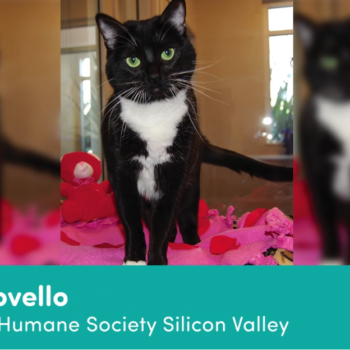“Meet Boo-Boo Kitty. Boo-Boo Kitty is 14 years old. She’s got arthritis and she’s in the early stages of kidney disease. She’s also a happy loving cat with a great quality of life. So let me ask you, would you adopt Boo-Boo Kitty?”
With those words, Humane Society Silicon Valley president Carol Novello opened her talk on her Aha! Journey at a recent Maddie’s Fund presentation at Animal Care Expo in Las Vegas.
Of course, it was an animal welfare conference, so plenty of people in the room said yes, they would. But to the general public, Boo-Boo Kitty might have been a bit of a tough sell. To Novello, who had only just come on board at the shelter after leaving a career as a software company executive, it was hard to imagine anyone would adopt her — but she also couldn’t imagine euthanizing an animal with “so much life left insider her and so much love to give.”
Novello went on to describe a stunning realization about not only this one cat, and how an Aha Journey — from inspiration to implementation to transformation — can begin with an organizational leap of faith:
Boo-Boo Kitty was one of my first major challenges.
The organization was divided. There was camp A, those who thought that Boo-Boo Kitty deserved a second chance, and there was camp B, those that thought she should be euthanized because they were far too many more adoptable animals out there. I decided to take a leap of faith that a potential adopter might actually be out there.
And what this unassuming friendly little black cat with her white habit taught me early on has helped shape Humane Society Silicon Valley ever since. Taking a leap of faith is actually the first principle in creating an organization that places hard to adopt animals. And taking that leap of faith has to start at the top of the organization.
I needed to assure my staff that no one was going to be penalized if length of stay numbers were longer, or if medical costs went up. I needed to make sure that staff had air cover when they wanted to help these animals. When there were others who were pushing back and saying we shouldn’t be bringing in these animals at all.
And personally I also needed to recognize it wasn’t about me. I didn’t know all the potential adopters that might be out there in the world. And it wasn’t my place to judge what others are and aren’t capable of taking on.
Boo-Boo Kitty’s adopter was more than willing to take on an older animal that had kidney disease in part because she resonated with Boo-Boo Kitty on a really personal level. You never know what will make a love connection. You do need to believe that one is possible.
And belief is actually the second principle in creating an organization that places hard to adopt animals. There is a lid for every pot. And if you believe it you will see it. That is a revolutionary mindset shift. When you do it, when you make that shift you unleash an army of people who want to mobilize and rally behind an animal.
Encourage your community and your organization to share that animal’s story. They can use social media. They can talk to everyone that walks through your doors. Boo-Boo Kitty ended up in the local paper because a volunteer took her time to send Boo-Boo Kitty’s picture in. And one of our animal care techs helped educate Boo-Boo Kitty’s adopter about what it would be like to have a cat that had kidney disease.
The people in your organization will advocate for the animals that they care about if they know that it is encouraged and expected that they do so.
Novello went on to describe two more animals who brought her to an Aha! Moment. Hear about them in her short talk below — and stay with us; we have more Aha! Journey stories on the way!

